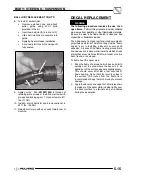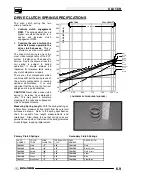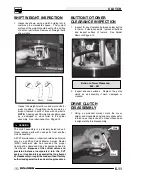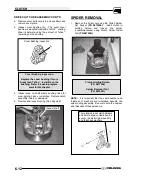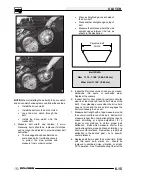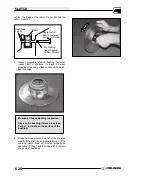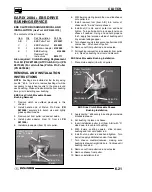
CLUTCH
6.6
PVT OVERHEATING/DIAGNOSIS
During routine maintenance or whenever PVT system overheating is evident, it’s important to check the inlet
and
outlet ducting for obstructions. Obstructions to air flow through the ducts will significantly increase PVT
system operating temperatures. The ATV should be operated in LOW RANGE when pulling or plowing heavy
loads, or if extended low speed operation is anticipated.
GENERAL RANGE OPERATION
GUIDELINES:
Low Range
: Heavy pulling, basic operational speeds less
than 7 MPH, riding through rough terrain (swamps, mountains,
etc..), low ground speeds.
High Range
: High ground speeds, speeds above 7 MPH.
Diagnosis of Clutch Drive Belt & Cover Related Issues:
Possible Causes
Solutions/What to do
Loading the ATV into a pickup or tall trailer
when in high range.
Shift transmission to low range during loading of the ATV to
prevent belt burning.
Starting out going up a steep incline.
When starting out on an incline, use low range, or dismount the
ATV after first applying the park brake and perform the “K”
turn.
Driving at low RPM or low ground speed
(at approximately 3--7 MPH).
Drive at higher speed or use Low Range. The use of Low
Range is highly recommended for cooler PVT operating tem-
peratures and longer component life.
Insufficient warm--up of ATVs exposed to
low ambient temperatures.
Warm engine at least 5 min., then with transmission in neutral,
advance throttle to approx. 1/8 throttle in short bursts, 5 to 7
times. The belt will become more flexible and prevent belt
burning.
Slow and easy clutch engagement.
Fast, effective use of the throttle for efficient engagement.
Continuous operation at the point of engagement (initial vehicle
movement) increases PVT temperatures and component wear.
Towing/Pushing at low RPM/low ground
speed.
Use Low Range only.
Plowing snow, dirt, etc./utility use.
Use Low Range only.
Stuck in mud or snow.
Shift the transmission to Low Range, carefully use fast,
aggressive throttle application to engage clutch.
Warning:
Excessive throttle may cause loss of control and vehicle
overturn.
Climbing over large objects from a
stopped position.
Shift the transmission to Low Range, carefully use fast,
aggressive, throttle application to engage clutch.
Warning:
Excessive throttle may cause loss of control and vehicle
overturn.
Belt slippage from water or snow ingestion
into the PVT system.
Shift the transmission to neutral. Using the throttle, vary the
engine rpm from idle to
3/4 throttle
. Engage transmission in
the lowest possible range and test for belt slippage Repeat
several times as required.
During this procedure, the
throttle should not be held at the full position for more
than 10 seconds
. PVT seals should be inspected for damage
if repeated leaking occurs.
Clutch malfunction.
Inspection/repair of clutch components should be performed by
a certified Polaris MSD techinician.
Summary of Contents for 600 Dragon SP
Page 1: ...2004 SPORTSMAN 600 700 SERVICE MANUAL PN 9918803 ...
Page 138: ...BODY STEERING SUSPENSION 5 16 NOTES ...
Page 210: ...FINAL DRIVE 7 38 NOTES ...
Page 293: ...ELECTRICAL 10 43 WIRING DIAGRAM HAND AND THUMB WARMERS WINCH HUNTER EDITION ...
Page 294: ...ELECTRICAL 10 44 NOTES ...
Page 300: ...ELECTRICAL WIRING DIAGRAM LATE 2004 SPORTSMAN 600 700 MODELS WITH FUEL GAUGE NOTES ...
Page 301: ...ELECTRICAL WIRING DIAGRAM 2004 SPORTSMAN 600 700 HUNTER EDT HAND WARM WINCH ...
Page 308: ...PN 9918803 Printed in USA ...








